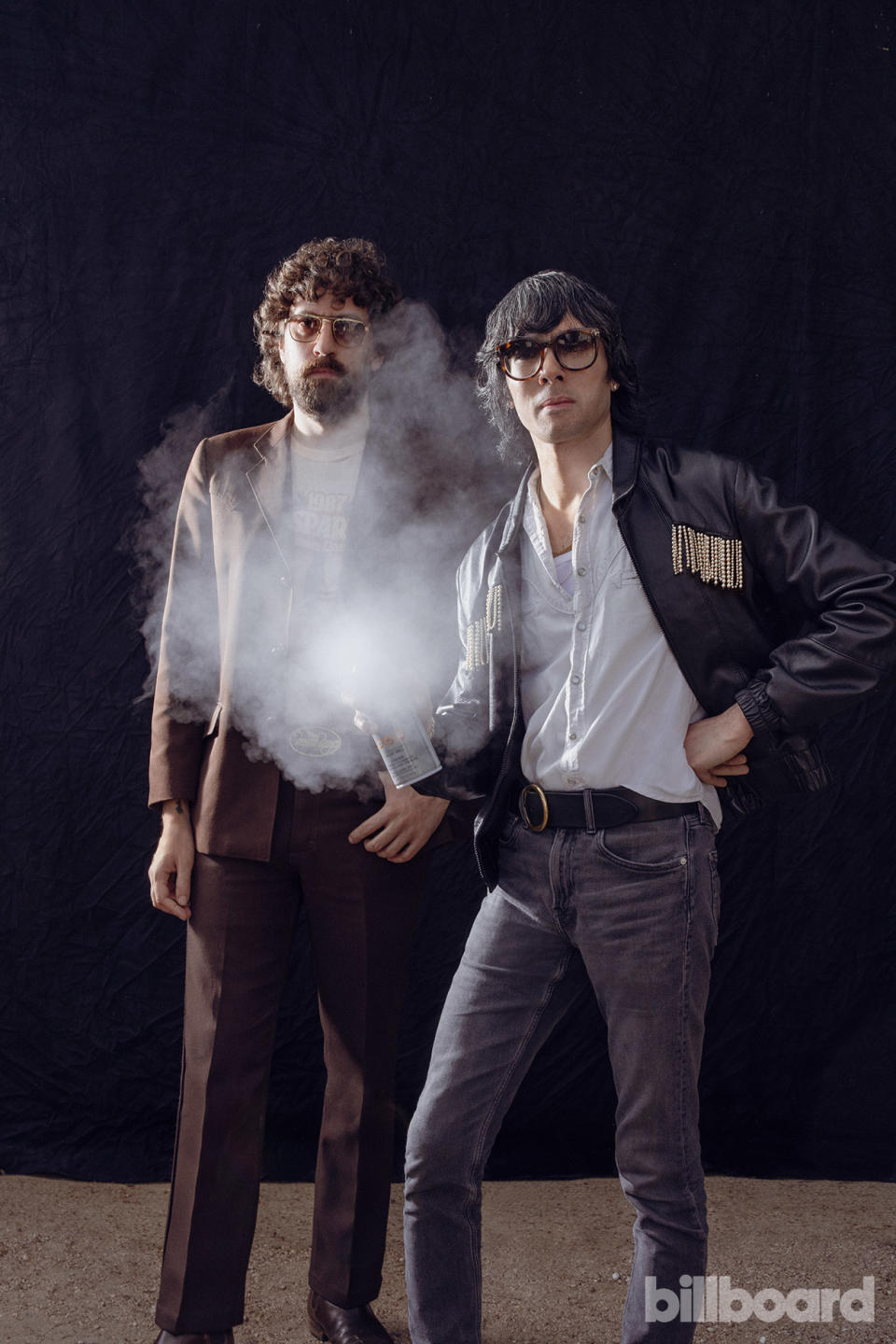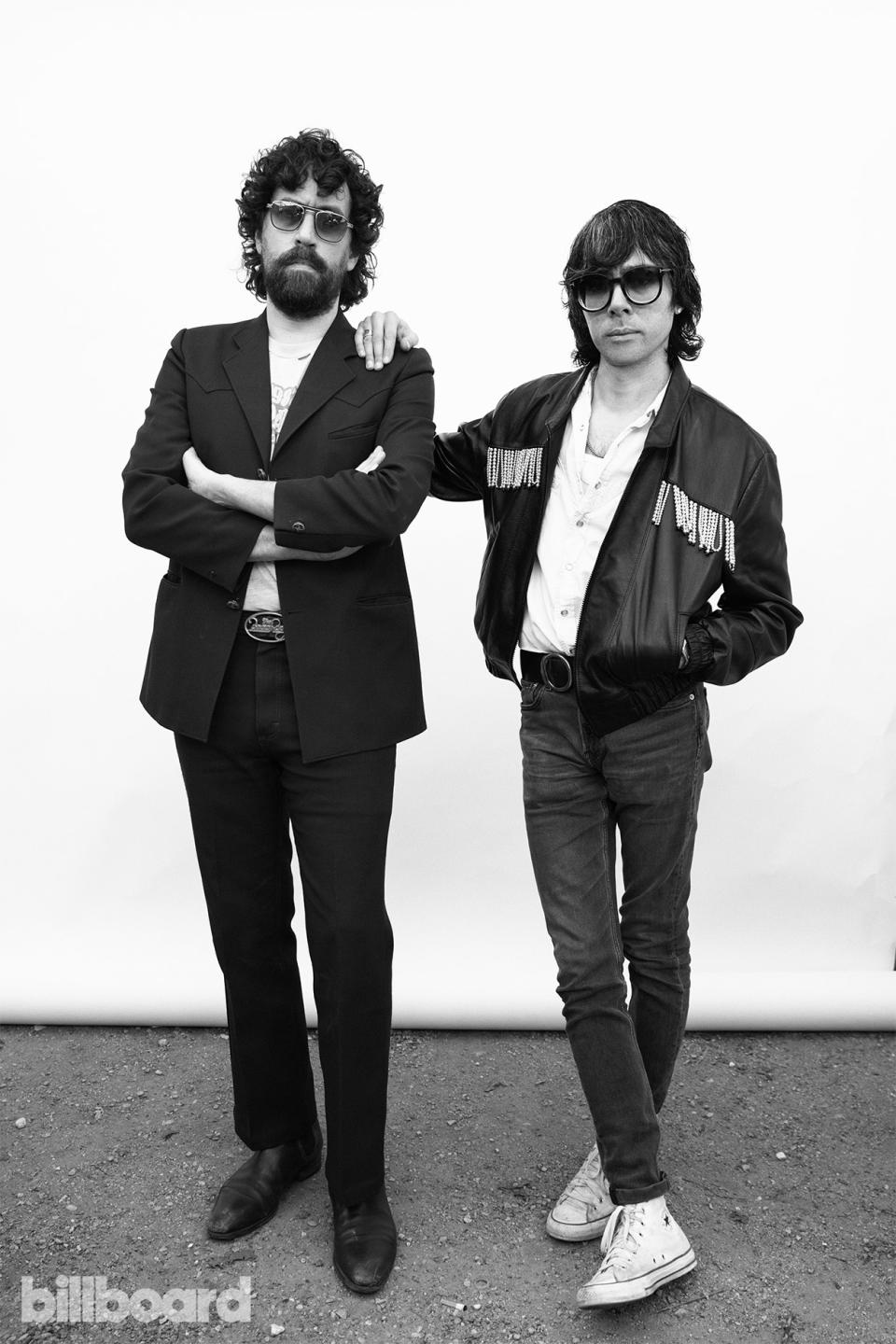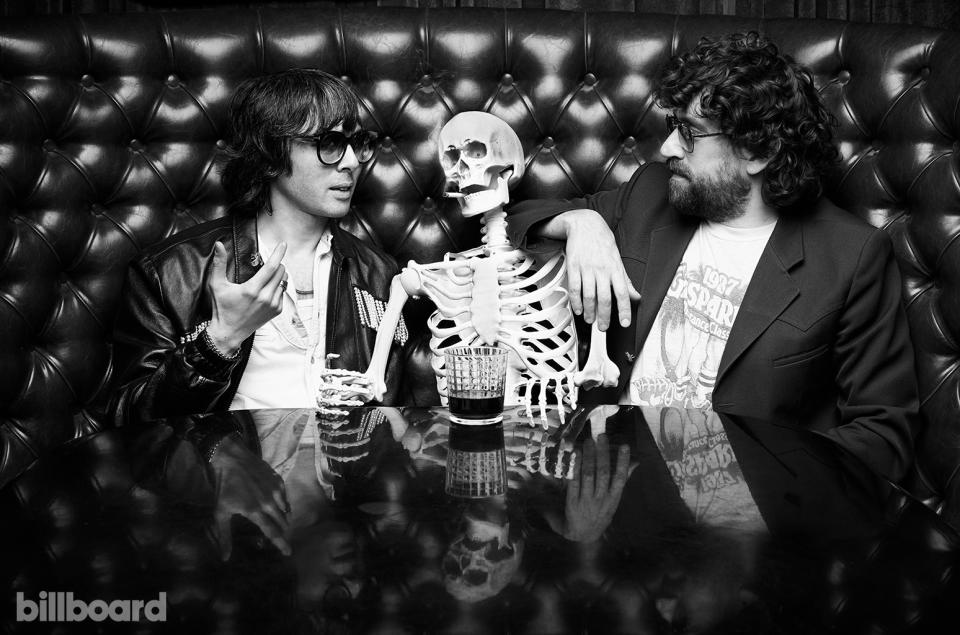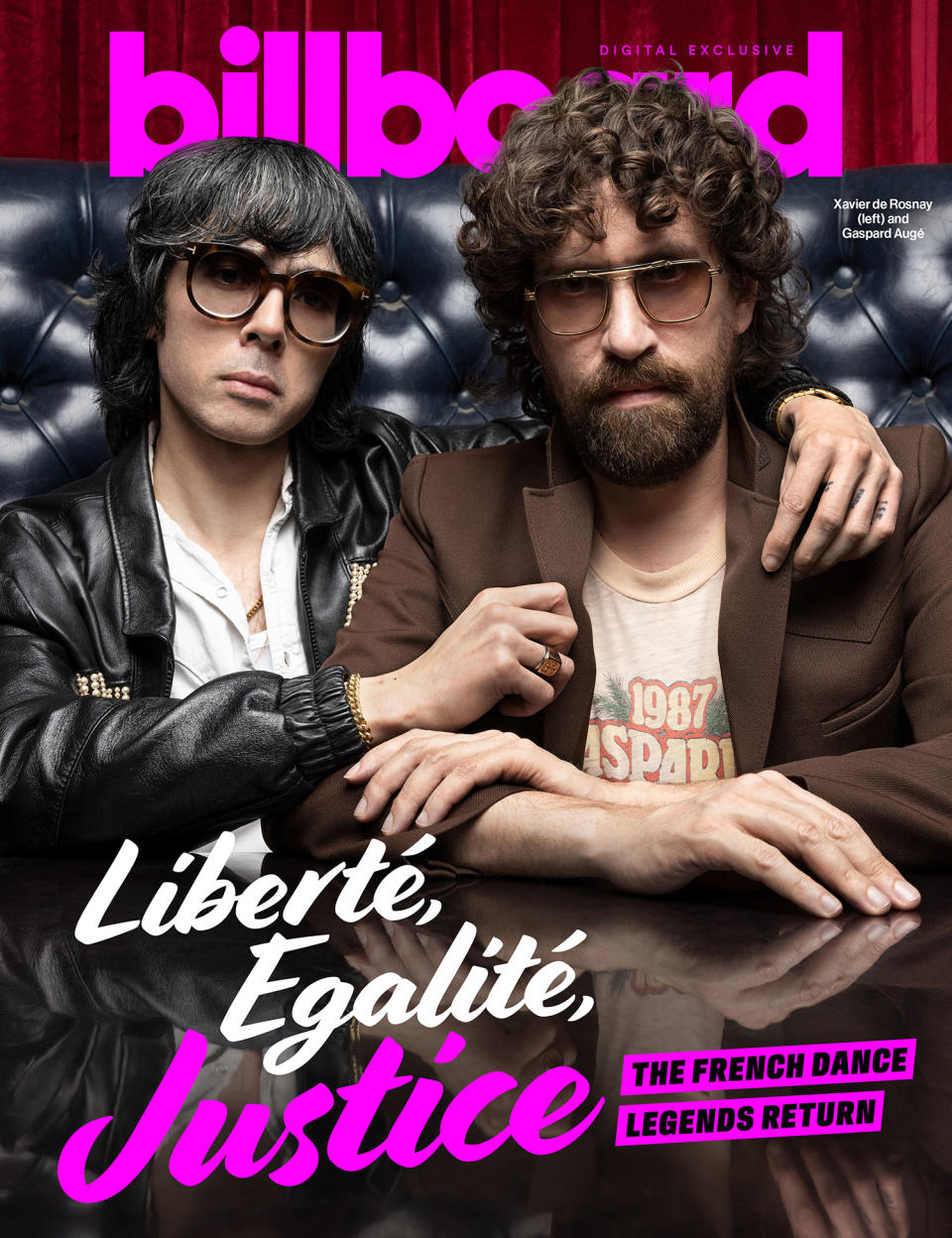Legendary Dance Duo Justice Opens Up Ahead of Coachella Return, With ‘No Idea’ Who Their Fans Are Now

On the scale of regular to rock star, being stuck in traffic leans hard into the mundane. And yet on a humid March afternoon in Texas, this is where I find Gaspard Augé and Xavier de Rosnay — the French electronic music legends better known as Justice.
Augé (44, bearded, tall, taciturn) is in the back seat of an air-conditioned Uber, texting. De Rosnay (41, clean-shaven, shorter, chatty) sits beside him, playing the trivia game on the tablet hanging from the back of the passenger seat, pressing answers with long, skinny fingers as the SUV lurches through the streets of Austin, gridlocked amid South by Southwest. (He gets most of them right — but asks for help when asked to identify New York state by its shape.) The pair arrived here yesterday from Paris, and de Rosnay’s luggage still hasn’t shown up. Last night he went on his first-ever Target run, to procure fresh underwear.
More from Billboard
Texas Eclipse Festival Insists Last-Minute Cancellation Was 'Not ... for Insurance Money'
Firebird Acquires Stake in JET Management, Home to Justice, Madeon & More
It’s cliché to assume that famous musicians exist in a fantasy bubble of perpetual ease, but you’d be forgiven for being somewhat perplexed by the idea of one-half of the revered duo buying a pack of Hanes at the self-checkout. Still, de Rosnay and his Justice collaborateur Augé look the part: the latter in a brown suit, a vintage ’80s T-shirt and a big belt buckle of gold metal forming the words “Beach Boys,” de Rosnay in dirty white Chucks, skinny black jeans and a black leather jacket strung with fake pearls. Streaks of silver run through his otherwise black hair, and the diamond stud in his left ear appears real. Both indoors and after dark, they keep their sunglasses on.
But despite looking like ’70s prog-rockers, in the Uber, they’re amiable, relaxed, funny. De Rosnay recounts the time France’s American Film Festival asked them to present a list of their favorite films but cut them from the program seemingly because their choices were too lowbrow. (“But Die Hard is a masterpiece of action film, you know?” he declares.) At this story’s photo shoot, they pull a plastic skeleton lurking in the studio into the frame between them, de Rosnay pouring it a fake cocktail of Diet Coke and Augé inserting a prop cigarette between its jaw bones. And while they partake in their bony friend’s faux cigs for the shoot, they don’t smoke, instead pulling on the little black vapes they intermittently produce from their jackets.
As Justice, Augé and de Rosnay are two of the most respected figures of the last 20 years of electronic music. Their 2007 debut, Cross, brought a fresh, swaggering, hard-edged rock aesthetic — “like the Led Zeppelin of the electronic scene,” says their longtime manager, Pedro Winter — to their native France and the world beyond, and it arrived just as blogs and file-sharing platforms fundamentally shifted how audiences access music. Beyond Daft Punk, they are arguably the best-known French electronic artists of all time, entering the public consciousness alongside a gang of Ed Banger labelmates who felt like the coolest guys at any given art school.
“I guess the U.S. electronic scene was not dormant, but focused on house, and we just entered like punks,” Augé says of the bold and pioneering rock-disco-electronic hybrid they stormed the scene with. Two lauded albums followed — 2011’s Audio, Video, Disco. and 2016’s Woman — and in 2019, Justice won the best dance/electronic album Grammy Award for the live set Woman Worldwide.

Now, the guys are in Texas for 36 hours as they prepare to release Hyperdrama, the first Justice studio album in eight years. Upon its announcement, the news rippled across the electronic music world like the second coming of Christ. But here over dinner — Augé has shrimp cocktail, tuna crudo and a margarita, de Rosnay steak frites and sparkling water — they seem sincerely unsure about who, if anyone, might listen to it.
“Because the album cycle is so long every time, we’re both like, ‘OK, is there going to be anybody that’s still interested?’” Augé says with a laugh.
“For real, no?” says de Rosnay. “We still feel like rookies every time.”
Given Augé and de Rosnay’s singular and perpetually evolving sound, their refusal to market themselves in inauthentic ways and the changes in the industry landscape between each of the duo’s albums, Justice has always existed on the fringes of market demand. But with Hyperdrama, there’s an ambition to “reach a wider audience,” says Winter, who has managed Justice since its formation; founded the act’s label, Ed Banger; and managed Daft Punk for over a decade.
“EDM has been so much on repeat in the U.S.,” Winter says over Zoom from his home in Paris, a tabby cat perched on his shoulder. “I think and I hope American people are ready for a new cycle and maybe a bit more ambitious music.”

Hyperdrama originated in February 2020, when the guys — still fairly fresh off the Woman cycle — started talking about new music. Having just played live shows that “almost contractually have to be fun immediately,” says de Rosnay, they were interested in making the less straightforward and less danceable music that has characterized their studio albums.
But the pandemic started weeks later, and by December 2020 they’d stopped working on the project entirely, since they couldn’t meet in person safely. Instead, Augé made his debut solo album, 2021’s Escapades, and de Rosnay enjoyed months of uninterrupted time with his daughter, who’s now 12 and whose photo is his phone’s wallpaper image. “It had been like 15 years that I hadn’t been in the same place for more than 10 days,” he says. “Four months in one place with my daughter — it can’t be cooler than this.”
Close friends for two decades, the guys kept in almost constant contact, and as the pandemic waned, they reunited in de Rosnay’s Paris home (a converted horse stable in the city’s 18th arrondissement) and got to work. For previous albums, they’d first spend countless hours digging for granular samples to build on. This time, they made those samples themselves. The idea was to combine the aggressive, visceral energy of techno, particularly its hardcore ’90s subgenre gabber, with what Augé calls “disco sauce.” The music would be at once mechanistic and human, cold and hot, synthetic and organic. (Each Justice album cover iterates the same monolithic cross logo; Hyperdrama’s art, conceived alongside visual artist Thomas Jumin, features a transparent cross with a set of ribs and a nervous system, which de Rosnay says reflects a body of work “about confronting digital things that are perfect and clean with more organic things.”)
In de Rosnay’s living room, they could simply hang out, cook, read and then work when inspiration came. “When you’re in a commercial studio,” says de Rosnay, “you can feel there’s an atmosphere of having to deliver something, having to be productive… and the environment is always a bit sterile. Sometimes you just want to spend half an hour in the home studio, but that’s going to be a good half an hour.”
Their pace was, he says, “very slow,” but over three-and-a-half years, they found the sound they’d been searching for, knowing they’d hit particularly good material when the music inspired them to shake hands and dance. (“If the track is on the album,” Augé says, “it means we high-fived over it at some point.”) Extending the album’s organic theme, this human chemistry has always been essential to their output.
“Having this moment by yourself, then sending it over on Dropbox and saying, ‘I think it’s kind of good; have fun on the other side,’ ” de Rosnay continues, “it would be impossible [for us] to do it at a distance like that.”

The first track to inspire such celebration was “Incognito,” a three-part opus that shifts gears between ’80s AM radio psychedelia, peak-hours techno and funk. Travis Scott’s multi-movement “SICKO MODE” made them realize that they were “still thinking about music almost in an ancient way,” de Rosnay explains. “Almost by reflex we were like, ‘OK, this song has to be a verse, a chorus, then a shorter verse, then a double chorus.’ ” Instead, they just made what “we wanted to hear, even if it doesn’t make sense in terms of music theory.”
They ultimately amassed over 200 versions of some tracks, and their only disagreement during the production process was about whether to include bongos on the song “After Image.” De Rosnay wanted them and Augé did not; the latter prevailed. (“I recorded the bongo part and it sounded perfect,” de Rosnay says. “I also knew when I was making it that he would hate it.”)
But what most listeners will notice first — maybe even before pressing play — are Hyperdrama’s featured vocalists, who make up the highest-profile collection of guests ever assembled for a Justice album. They’d had Kevin Parker in mind as a vocalist for “almost a decade,” ever since Justice was asked to remix Tame Impala’s 2012 single “Elephant.” (They turned the project down because they didn’t think they could make the original any better.) Parker sings on the album’s lush, punchy lead single, “One Night/All Night,” as well as the gliding album opener, “Never Ender.” They were already friendly with Thundercat and Miguel through Los Angeles nightlife, and they appear on the tough, cinematic album closer, “The End,” as well as the swaggering “Saturnine,” respectively.
One notable artist who doesn’t appear on the album: The Weeknd. In January, a demo of a track Justice did for him leaked online around the same time that the pop star shared several Justice-related images on his Instagram story, fueling rumors that he’d appear on Hyperdrama. The guys now say they never planned to have The Weeknd on the album and that they didn’t even hear the leaked demo before it was taken down. “Like many of those kinds of artists, The Weeknd is working with 10 different producers,” Winter says, adding that “there might be some collaboration happening” between the two acts “in the future.”
I ask Winter if working with more high-profile vocalists was an intentional move to grow Justice’s fan base. “No. No, no, no. It’s definitely not systematic,” he insists. His take is that the duo — which he calls “the boys,” of whom he is “a proud daddy” — is simply more mature, more confident in its production skills and “don’t have that much to prove anymore,” inspiring the act to partner with collaborators who felt like authentic fits.
“Justice has been a band saying ‘no’ to everything, exactly like when I used to work with Daft Punk,” Winter says. “They really wanted to focus on their own music. Now it has been a 20-year career, so it’s time to open the door and work with other people.” He does admit that having names like Parker or Miguel on the track list can’t hurt. “Of course, a lot of [their fans] will not get the Justice sound… but out of those millions, let’s try to grab the attention and love of some of them.”
Still, de Rosnay says, he and Augé “have no idea who the average Justice fan is. We have no idea if that person likes ‘D.A.N.C.E.’ or likes ‘Stress,’” he continues, referencing two early Justice singles. “We have no idea if they like stuff like Woman. It’s impossible, so we decided not to take that into account at all.”
Regardless of who may comprise that fan base, there’s no doubt that it exists in large numbers. Like Cross, Woman reached No. 1 on the Top Dance/Electronic Albums chart, while Audio, Video, Disco. hit No. 37 on the Billboard 200 in November 2011. Justice has singles scattered across 13 Billboard charts, and its catalog has aggregated 63.3 million official on-demand U.S. streams, according to Luminate. This body of work has also amassed 224.2 million on demand global streams since 2020, when Billboard’s global charts were launched, a number that’s particularly significant given that the act hasn’t released a studio album during this time frame.
Of course, devotees don’t need any data beyond “new Justice album” to get hyped.
When they first got together, after meeting at a Paris house party back when they were both graphic designers, even Augé and de Rosnay weren’t sure what Justice was. They’d met Winter through visual artist So-Me, the Ed Banger art director who was also the duo’s roommate; the trio had gone to Augé’s parents’ house for raclette and “Pedro invited himself because his own home was raclette free, and he was craving for one,” de Rosnay says. Their first release, “We Are Your Friends,” a remix of Simian’s 2002 “Never Be Alone,” was released on Ed Banger in 2006 and almost immediately became the defining anthem of the indie sleaze era.
Emmanuel de Buretel, the head of Ed Banger parent label Because Music, signed Justice around the time it released that remix, having seen the global appetite for French electronic music after he signed acts like Daft Punk and Air. “We love him,” de Rosnay says, “because he’s really a believer that things don’t always produce results immediately.”
The duo’s first original production, the brash, distorted “Waters of Nazareth,” sounded nothing like “We Are Your Friends,” with the song “alienating people” immediately upon release, says de Rosnay. “Even Pedro didn’t want to release [“Waters of Nazareth”] at first.” (It was the late DJ Mehdi, he says, who convinced Winter to put it out.) Every time Justice played it live, audio techs rushed the stage to see if there was a problem with the cables. Friends suggested something might have gone wrong with the vinyl pressing.
“We thought maybe we should have done something else, but then slowly, it started to get noticed,” de Rosnay says, “and it dragged in another crowd of people that were more interested in rock. Like, if The White Stripes made an electronic track, it would sound like ‘Waters of Nazareth.’ ” The act’s second single, the giddy earworm “D.A.N.C.E.,” featured a children’s choir singing over nu-disco production and further confused things. Then, the pair’s third single, the cacophonous and aptly named “Stress,” “alienated the people who liked ‘D.A.N.C.E.’ “
But the strength of those early singles helped Justice get booked for Coachella in 2007, appearing on the lineup’s bottom row; two months later, Cross came out, becoming a critical and commercial hit despite the fact that making it had been, as de Rosnay puts it, “a struggle at every level, because we had no idea what we were doing” (the duo had also just bought a computer for the first time two years prior). The album’s success validated the act — to an extent. In the wake of Air and Daft Punk — the latter of which wrapped its groundbreaking Alive tour in 2007 — Justice almost assumed such success was standard for a French electronic act. “When we started making music in 2003, thanks to them it was almost normal that you put out a record and everybody on the planet listened to it,” de Rosnay says.
But by the time the duo released Audio, Video, Disco. four years later, its sound had changed again (de Rosnay calls that album “inspired by our love of agricultural ’60s British rock”), along with almost everything about how music was distributed and the broader dance landscape: The EDM boom’s neon and MDMA world was the sonic and spiritual opposite of Justice’s dirty jeans and cigarettes vibe. By the time Woman arrived in 2016, the dominance of digital service providers had increased even more exponentially.
It’s fair then that, sitting here at dinner, the guys aren’t really sure who Hyperdrama is for, or how it will be discovered. They’re unlikely to seek new listeners on TikTok, a platform de Rosnay says they are not “naturally inclined to do” (and anyway, as Winter notes, the four-plus-minute-long songs on Hyperdrama aren’t exactly “TikTok- or Spotify-friendly”). Synchs have helped Justice’s exposure and revenue — the act’s music has appeared in ads for brands like Nike, Adidas and Volvo, in films like John Wick 4 and on TV shows like Netflix’s The Gentlemen — and at an album listening event for music supervisors in Los Angeles last winter, a label representative advised the group to keep Hyperdrama in mind “for your car chase and fight scenes.” The handful of DJ sets the act plays annually (mostly for friends or “events that we feel are interesting for us,” de Rosnay says) are both lucrative and no doubt a reminder to old and new fans that Justice is still a tastemaker.
Still, de Rosnay admits, “[We] have no idea how much we get paid from streams. Not that we don’t care, but we don’t really look out for that.” With so much time between projects, he continues, “every time we finish making a record, we are, like, ruined.”
“Like, bankrupt,” Augé says.
“Like, we don’t have any money left,” de Rosnay adds. “Because every penny we make with Justice, we invest into stuff that’s not necessarily commercially viable” — like the duo’s live albums (which he calls “almost like a preplanned commercial failure”), complicated and costly concerts and performance films like 2019’s IRIS: A Space Opera by Justice.
Yet, the two agree that “as long as we are not in dire need, we don’t need to earn more money,” de Rosnay says. “We have houses. We have fun. We have food. It sounds cliché, but that’s the truth.”

But while they say that Hyperdrama, like everything else they make, is about passion, artistic integrity and creating an enduring body of work, Winter sees more. “It has been 20 years, and of course we can say Justice had a couple of singles, but it’s not a success story yet,” he says. While massive streaming numbers are “definitely not a goal, I’ll be happy if the songs [get more than] 1 million plays on Spotify. One million plays — we are a joke compared to electronic music today. We are not chasing that, but I think they deserve it.”
And anyway, anyone who has seen the act live knows there’s no better Justice marketing tool than a Justice show — a quasi-religious experience that amalgamates the entirety of the duo’s catalog into a wall of pummeling, pristine electronic glory. The guys spent months working with a team of seven computer scientists to make their new live show, which they’ll debut April 12 at Coachella — a proving ground for ambitious dance productions dating back to Daft Punk’s historic unveiling of its pyramid in 2006. Having risen to the second-from-the-top line of the lineup in the 17 years since their first appearance, they’ll close out the festival’s second-largest venue, the Outdoor Stage.
“Coachella is the festival of all festivals,” Winter says. “To start the tour there is the best promotion you can have.” After that, Justice plays two dates in Mexico (the duo’s leading territory, according to Winter), then a flurry of European summer festivals before returning to North America for four East Coast dates and more on the other side of the country that will be announced in the coming weeks.
“There is definitely big ambition in the U.S. market,” Winter says, adding that South and Central America are also “huge.” The tour ends at Paris’ Accor Arena in December, with a second night added since the first sold out. Winter says he’s “sure they will do a live album” in conjunction with the tour, as is their tradition.
Augé takes French fries off de Rosnay’s plate without asking and recalls throwing him a 40th birthday party in the French countryside last summer, an event for which they bought out a small hotel and had their friends who run the kitchen roast several pigs. De Rosnay’s daughter is starting to understand what her dad does for work. When she heard him playing a demo of “One Night/All Night” on his phone, she told him it was “surprisingly good, for something you made.”

Twenty years into their career, de Rosnay and Augé discuss their relationship in couples therapy terms (outside of Justice, both are unmarried). The secret of their success, de Rosnay says, is “patience, good communication. We’re in a band together; we are friends on a very intimate level. It’s likely that there’s not a lot of our romantic partners who can claim to know us better than we know each other.”
They still seriously consider a backup plan if things don’t ultimately work out in music. Augé says many of their musician friends are no longer pursuing careers in the industry, given its volatility; de Rosnay is confident they could still get work as graphic designers. But he also admits that should they follow that path, it’s “not going to be as cool as being in Justice.”
And for the time being — regardless of who they think their audience is or is not — they’ve got millions of prospective new listeners and a devoted global fan base that considers them actual rock stars.
“Please don’t break the news,” de Rosnay says with a smile, “that we are not.”

Best of Billboard
H.E.R. & Chris Brown 'Come Through' to No. 1 on Adult R&B Airplay Chart
Anne Wilson's 'I Still Believe in Christmas' Crowns Christian Airplay Chart

